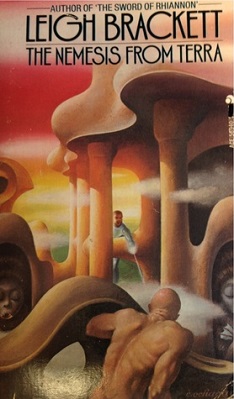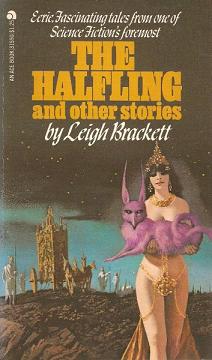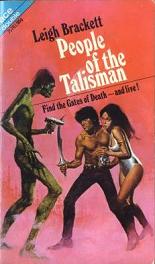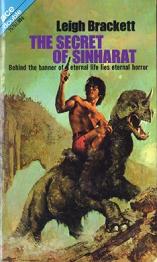
The Nemesis from Terra
Leigh Brackett
150 pages
published in 1961
One of the disadvantages of the exploration of the Solar System that got started up in the middle of the 1960s is that it destroyed the cozy picture science fiction had build up over the decades. Gone were the humid jungles of pulp Venus, the night and day sides of Mercury and of course most famously, the Martian channels and any hope that it may yet be a habitable planet. Though I was born well after the pulp sf ideas about the Solar System had been shown to be false, I still like reading about it, as long as it’s not some hideously reactionary re-imagination of it but the real deal. Leigh Brackett of course always satisfies and it’s no different here.
Rick Urquhart is space scum, kicked off his last ship’s crew for slugging the first mate and currently running away from the press gangs sweeping through the ancient Martian city of Ruh, looking for fresh bodies to use in the mines of the Terran Exploitations Company. When he stumbles into one Martian hidey hole, the old crone living in it, suggests she tells his future, to kill the time, hoping no more than to hypnotise Rick and shove him outside. Much to her surprise however she finds out his shadow will hang over Mars unless she kills him now. Rick struggles and kills her, then flees only to run into another press gang. For somebody prophesied to be the new ruler of Mars, he has remarkable little luck…
As Rick is stewing in the mines, he keeps looking out for chances to escape to fullfill his destiny to rule Mars, which is how he interprets the crone’s prediction. He’s not the only one: his killing of her is the catalyst for a Martian uprising. For the first time, the city states stand as one in a conspiracy to throw the Terran Exploitations Company off Mars, preferably with all other humans. And they’re not the only ones after the TEC: there’s also the Union Party, full of Terran do gooders wanting to raise the Martian living standard and make it an independent planet. One of them, Mayo McCall, has infiltrated the TEC and is present when Rick tries to escape.
Her cover is blown in the attempt and she and Rick flee into the mine tunnels, in the most harrowing part of the novel. Pursued by the company’s watch dogs they move deeper and deeper into the mine, coming out in the tunnels dug by one of Mars’ natural tunnellers, a giant worm like creature, whose carcass they have to move through to get to the surface. More dead than alive they reach another of Mars many half ruined cities, where Rick and Mayo are looked after by Kyra, one of the last surviving members of an ancient Martian race. These tend to crop up a lot in Brackett’s work.
Meanwhile, TEC’s second in command, Jaffa Storm, has taken over the company and crushed the first Martian rebellion, but not before Rick had been taken prisoner by them and tortured on behalf of the son of the woman he’d killed. With the leaders of the rebellion now dead and Rick’s destiny still playing in the back of his head, he persuades Mayo and Kyra to help him organise a new one, using Mayo’s contacts in the Union Party, his own among the spacer community as well as the indigenous Martians, already organised. Together they beat TEC, but Storm escapes while Rick is betrayed. It all comes to a climax in the abandoned city of yet another Martian race as Rick has to chose between power and love…
The Nemesis from Earth started out as “Shadow over Mars”, originally printed in the Fall 1944 Startling Stories. With such a pulp background it’s no surprise it packs a lot of action in its 150 pages, with the characters being a bit twodimensional. What is surprising though is the relative sophistication of the politics. This is no simplistic story of heroic natives rising up against an exploitative company; the Martians have their faults, TEC itself has some good points and the Union Party is willing to use realpolitik to achieve its goals. It’s all rooted in a mid twentieth century understanding of colonial politics; it could’ve been set in an African or Central American country except, you know, for the mind powers and such.
In the end The Nemesis from Terra is a minor Brackett story, not as refined or interesting as her later Mars stories. But it’s a quick read and the action is fat enough to keep your attention.



